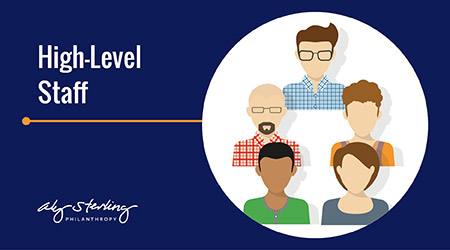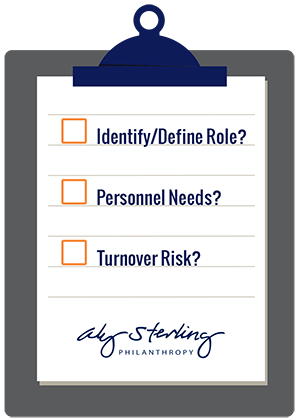The Complete Nonprofit Succession Planning Guide
Plan for your nonprofit’s next leadership transition with our guide
Nonprofit Succession Planning Guide [With Templates]
Nonprofit Succession Plan
The Basics of Nonprofit Succession Planning

What are nonprofit succession plans?
A succession plan is a nonprofit’s outline for how they’ll ensure leadership continuity in the event of a key change in personnel within the organization. In this plan, the nonprofit outlines how they’ll cover the necessary workload, pull together a team, and ensure the success of a new leader.

Why are succession plans important?
Without developing a well thought-out nonprofit succession plan, organizations open themselves up to serious performance risk. If they are unable to effectively bridge the knowledge gap after a key member departs, there’s also the risk of losing the support of board members and donors.

How do these plans benefit nonprofits?
If a nonprofit already has crafted a succession plan when a leader makes their departure, they can ensure a smooth transition as their new leader takes on their role. Additionally, by spending time planning out how they’ll make their replacement, the nonprofit can avoid bringing on an unqualified leader.
Leadership Roles That Require a Nonprofit Succession Plan

Executive Director
Nonprofit succession plans are most commonly developed to ensure a smooth transition after the departure of the executive director of an organization.
Since so much of a nonprofit’s reputation among the giving community hinges on how people perceive the leadership strengths of their executive director, having a fail-safe plan in place can be crucial to making it through the switch from one executive director to the next.

Board Members
Nonprofits should also have succession plans on hand to help replace departing board members. You can develop individual plans for different seats on the board, or a comprehensive plan for all board members.
Because board members themselves tend to be high contributors as well as key networking resources, it’s important to plan for how your organization will oversee their departure.

High-Level Staff
Your executive director isn’t the only position of your staff for which you should have a succession plan. High-level positions such as your development director or major gift officer can also benefit from developing these plans.
The success of your nonprofit depends upon many individuals working together in harmony, and for this reason your team should never risk being unprepared for a staff transition.
Leadership Roles That Require a Nonprofit Succession Plan

Executive Director
Nonprofit succession plans are most commonly developed to ensure a smooth transition after the departure of the executive director of an organization.
Since so much of a nonprofit’s reputation among the giving community hinges on how people perceive the leadership strengths of their executive director, having a fail-safe plan in place can be crucial to making it through the switch from one executive director to the next.

Board Members
Nonprofits should also have succession plans on hand to help replace departing board members. You can develop individual plans for different seats on the board, or a comprehensive plan for all board members.
Because board members themselves tend to be high contributors as well as key networking resources, it’s important to plan for how your organization will oversee their departure.

High-Level Staff
Your executive director isn’t the only position of your staff for which you should have a succession plan. High-level positions such as your development director or major gift officer can also benefit from developing these plans.
The success of your nonprofit depends upon many individuals working together in harmony, and for this reason your team should never risk being unprepared for a staff transition.
Understanding the Different Types of Leadership Succession for Nonprofits

Strategic Planning
One type of succession plan that nonprofits develop is strategic leadership planning. In this type of plan, organizations map out how they’ll foster talent internally and develop staff members into future leaders.
With such a high turnover rate in nonprofit sector employment, retaining experienced staff members is one of the biggest challenges nonprofits can face. With strategic leadership planning, organizations craft a long-term succession plan to ensure continued success.

Emergency Departure
In an emergency departure succession plan, nonprofits outline how they’ll replace key leaders in the event that they unexpectedly leave the organization. This may be the result of a termination, resignation, or death that results in a leader quickly vacating their position.
To avoid having a prolonged absence in the leadership role, nonprofits craft emergency departure plans to map out how to bridge the gap as quickly as possible while still ensuring the right new leader is brought on.

Planned Departure
Succession plans for a planned leadership departure are crafted to ensure that long-awaited leadership transitions are handled as carefully as possible.
A planned departure may anticipate a retirement, a temporary sabbatical, or a maternity/paternity leave and are typically announced at least 1-3 years in advance of the role being vacated. Planned departure succession plans typically have the highest degree of oversight from the individual leaving the leadership role.
Laying the Groundwork for Your Nonprofit Succession Plan

Identify and Define Leadership Roles
As you develop your nonprofit’s succession plan, one of the first things you should address is your understanding of each leadership role at your organization.
Without a clear definition of each position as well as an in-depth understanding of the demands of each role, you risk misunderstanding what is needed for these leaders to be successful.
Your succession plan could be incredibly extensive, but without a fact-based assessment of the responsibilities and challenges taken on by those occupying the position(s), you can’t ensure that your plan will find the right new leader for your team.
Assess Personnel Needs
One of the best ways to understand the role that your succession plan addresses is to engage with current personnel and ask for their take on the demands of the leadership position.
Your team can interview current and past occupants of the role as well as anyone who works directly with the individual currently in the position.
In addition, take this as an opportunity to assess strengths and challenges that the current (or most recent) occupant has faced. Can your nonprofit consider their tenure a success, or is this leadership change an opportunity for reorienting the role?
Determine Turnover Risk
If the role your succession plan is designed to address is still occupied without a plan for departure, your team should make an assessment of the turnover risk for the position.
Do you expect the current occupant to depart from the role with the year? Within 3-5 years? At this point, it’s important to determine how long you expect the position to remain under the same leadership.
By making this assessment, your team can get a better idea of how to structure the timeline of your succession plan as well the amount of time you’ll have to mount an executive search process.
Laying the Groundwork for Your Nonprofit Succession Plan

Identify and Define Leadership Roles
As you develop your nonprofit’s succession plan, one of the first things you should address is your understanding of each leadership role at your organization.
Without a clear definition of each position as well as an in-depth understanding of the demands of each role, you risk misunderstanding what is needed for these leaders to be successful.
Your succession plan could be incredibly extensive, but without a fact-based assessment of the responsibilities and challenges taken on by those occupying the position(s), you can’t ensure that your plan will find the right new leader for your team.
Assess Personnel Needs
One of the best ways to understand the role that your succession plan addresses is to engage with current personnel and ask for their take on the demands of the leadership position.
Your team can interview current and past occupants of the role as well as anyone who works directly with the individual currently in the position.
In addition, take this as an opportunity to assess strengths and challenges that the current (or most recent) occupant has faced. Can your nonprofit consider their tenure a success, or is this leadership change an opportunity for reorienting the role?
Determine Turnover Risk
If the role your succession plan is designed to address is still occupied without a plan for departure, your team should make an assessment of the turnover risk for the position.
Do you expect the current occupant to depart from the role with the year? Within 3-5 years? At this point, it’s important to determine how long you expect the position to remain under the same leadership.
By making this assessment, your team can get a better idea of how to structure the timeline of your succession plan as well the amount of time you’ll have to mount an executive search process.
Cultivating Future Leaders for Your Nonprofit

Single out leadership prospects
As you plan for the future, who on staff does your team anticipate would make a successful transition into the role?
Since preventing excessive staff turnover is one of the key challenges nonprofits face, promoting from within can be an excellent way to maintain consistency among your staff as individuals transition out of leadership roles.
During the development of your succession plan, your team can meet with these leadership prospects and discuss their interest in eventually taking on the role. Do they seem committed to remaining a part of your nonprofit in the long term?
At this juncture, your nonprofit should also evaluate how equipped these prospects are to take on the role in the future. Ask yourselves:
- Do they need additional training or education?
- Could they benefit from mentorship from the current individual in the role?
- Are there multiple individuals primed to transition into this position?
As your nonprofit finalizes the succession plan, it’s best to have several qualified internal prospects for the role in question so that your team will have options if circumstances change down the line.

Grow the leadership role in question
Your nonprofit’s succession plan shouldn’t just be about finding a replacement for a departing leader: it should also be an opportunity to evolve the role in question.
Even if the current occupant of the position is successful by all metrics, that doesn’t mean that the role itself is equipped to meet the needs of your growing organization.
As your team crafts its succession plan, determine how the new leader in the role could do more for your nonprofit.
Determine the qualities you’re looking for in a leader occupying the new-and-improved version of the leadership position. Ask yourselves:
- What circumstances have changed since the current leader took on the role?
- How do leaders at equivalent organizations compare?
- Can continuing challenge points in other leadership roles be absorbed into the updated position?
Once you assess the ways in which your nonprofit would like to see the position grow, your team can incorporate that into how you evaluate leadership prospects during the search process.
Ensuring the Success of Your Nonprofit Succession Plan

Nonprofit Consultant
As your organization crafts its nonprofit succession plan, you might consider hiring a consultant to guide the process for your team.
Typically, the development of succession plans falls under the strategic planning umbrella of nonprofit consultation services.
Not only will a consultant offer expert insight, they can also take a step back and provide a measured perspective into how your team can leverage this plan to strengthen your organization’s overall strategy from the top down.

Robust Onboarding
Another way your nonprofit can ensure the success of your succession plan is to thoughtfully onboard your new leader.
During this time, you’ll give the individual the training and tools they need to thrive in the position.
For individuals new to your organization, you may also consider introducing them to aspects of your organization’s culture and traditions that are necessary for them understand in order to be successful team leaders.

Performance Checkpoints
Finding the right candidate for your vacant leadership position is just half the battle.
To ensure continued success, introduce performance checkpoints to assess how well the leader is adapting to the transition.
Don’t just look for indications that the individual is struggling in their role, but also determine where they flourish. In these evaluations, you can assess how to improve their performance as well as how to translate their strengths into other aspects of your organization.
Nonprofit Succession Plan Timeline

Month 0-12: Develop Succession Plan
The succession plan development process should take at least 12 months. For this reason, it’s integral that your team doesn’t wait until a leadership position is vacant to craft your plan. However, it’s never too late to start planning.
Month 12-18: Position Recruitment
After the succession plan is developed, the recruitment process typically takes about 6 months to conduct. This includes identifying prospects, accepting formal applications and assessing preliminary candidates before interviews.
Month 18-21: Candidate Interviews
After identifying ideal candidates for the position in question, take about 3 months to carefully conduct interviews. Remember, you’ll need to hold several rounds of interviews to narrow down the candidate pool enough to make an informed decision.
Month 21-24: Position Onboarding
Onboarding should take anywhere between 3 and 6 months before your new leader is fully transitioned into the role. During this time, your team can determine whether or not the individual is a good fit for the position in the long term.
Nonprofit Succession Plan Timeline

Month 0-12: Develop Succession Plan
The succession plan development process should take at least 12 months. For this reason, it’s integral that your team doesn’t wait until a leadership position is vacant to craft your plan. However, it’s never too late to start planning.

Month 12-18: Position Recruitment
After the succession plan is developed, the recruitment process typically takes about 6 months to conduct. This includes identifying prospects, accepting formal applications and assessing preliminary candidates before interviews.

Month 18-21: Candidate Interviews
After identifying ideal candidates for the position in question, take about 3 months to carefully conduct interviews. Remember, you’ll need to hold several rounds of interviews to narrow down the candidate pool enough to make an informed decision.

Month 21-24: Position Onboarding
Onboarding should take anywhere between 3 and 6 months before your new leader is fully transitioned into the role. During this time, your team can determine whether or not the individual is a good fit for the position in the long term.
Additional Nonprofit Succession Planning Resources
NONPROFIT EXECUTIVE TRANSITION PLAN
Navigating the departure of an executive director can be challenging.
By planning ahead, your nonprofit can weather this change more effectively.
Development Director Job Description
Development directors play a crucial role in your nonprofit’s fundraising success.
Find the right one for your organization using this job description.
Fundamental Fundraising Plan Template
Ready to get started planning your nonprofit’s next big fundraising campaign?
Use our comprehensive fundraising plan template to get started.
PO BOX 140668
TOLEDO, OHIO 43614
The Nonprofit Store
Your one-stop-shop for high-quality, affordable DIY tools focused on fundraising, strategic planning and board governance.
News & Resources
Sign up for our email newsletter and receive FREE resources, exclusive tips, news and offers!
Have A Question?
Contact us for more information about our services and how we can help your mission.
THE NONPROFIT STORE
Your one-stop-shop for high-quality, affordable DIY tools focused on fundraising, strategic planning and board governance.
NEWS & RESOURCES
Sign up for our email newsletter and receive FREE resources, exclusive tips, news and offers!
HAVE A QUESTION?
Contact us for more information about our services and how we can help your mission.